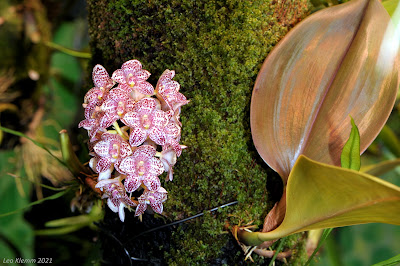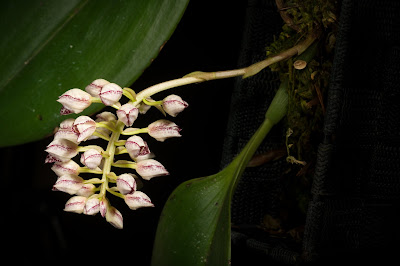Bulbophyllum kubahense, also called as The Kubah National Park Bulbophyllum is known from a single population in Kubah National Park, Kuching Prov...
Bulbophyllum kubahense, also called as The Kubah National Park Bulbophyllum, is a species of the genus Bulbophyllum. This species was described by Jaap J. Vermeulen and Anthony Lamb in 2011.
IDENTIFY BULBOPHYLLUM KUBAHENSE - THE KUBAH NATIONAL PARK BULBOPHYLLUM
Bulbophyllum kubahense is native to Borneo. The species is known from a single population in Kubah National Park, Kuching Prov., Sarawak, Malaysia. It is found as epiphyte near the forest floor, on non-calcareous soil, in lowland dipterocarp forest at elevations of 100-200 meters above sea level.
It is a miniature sized, hot growing low level epiphyte with distant, cylindrical, 2-3.5 × 0.7-0.9 cm. The single dark green leave is apical, erect, coriaceous, elliptic, acute to acuminate, gradually narrowing below into the petiolate base.
The Kubah National Park Bulbophyllum blooms in late spring from the patent, short, 9.5–11.5 cm long, 15 to 17-flowered inflorescences. The flowers are 2.5 cm across, not resupinate, fully opening, many simultaneously. The sepals and petals are white with large reddish purple spots, margins also reddish purple. Lip white, stained with reddish purple, greenish near the base.
BULBOPHYLLUM KUBAHENSE - THE KUBAH NATIONAL PARK BULBOPHYLLUM CARE AND CULTURE
Cultural information should only be used as a guide, and should be to be adapted to suit you. Your physical location; where you grow your plants, how much time you have to devote to their care, and many other factors, will need to be taken into account. Only then can you decide on the cultural methods that best suit you and your plants.
Light:
Bulbophyllum kubahense needs intermediate light about 15000-20000 lux. Higher light, that does not damage the leaves, seems to result in better and more frequent blooming. They can be grown indoors providing they receive good light.
Temperature:
The Kubah National Park Bulbophyllum requires warm temperatures from 21-27°C but will be comfortable in a temperature range of 7 to 35°C. They will not tolerate frosts. They need a temperature drop of about 6-8°C at night for flowering.
Humidity:
The plant prefers high levels of humidity (about 70%) and very good air circulation year round. Good air movement is important to reduce the problem of leaf fungal disease due to frequent watering.
Substrate, growing media and repotting:
Bulbophyllum kubahense can be grown mounted on slabs of cork or tree fern. However, the species can be grown in shallow pots, or even baskets. One requirement is to retain enough moisture at the root, as the plant don’t like to dry out. The rhizome can be trained to stay in the pot by bending them, eventually cutting the old bulbs and leaving them in place, so they will provide additional growth in the pot. Sphagnum has been popular because it retains a lot of moisture, which is what these plants prefer when in active growth; however when it decays or starts to retain too many salts, the plants will have problems. A mixture of small bark and perlite is also suitable.
Repot as infrequently as possible. Repotting is best done in spring or autumn when new growth appears at a frequency of about every 3 years.
Watering:
The Kubah National Park Bulbophyllum need to have ample water supply when the plants are in active growth, and a drought of even a couple of days is enough to kill the new growths and set back the plant. Due to their shallow fine root system they need to have constant moisture around their roots, however depending on their origin, some need a distinct wet and dry period to flower. The potting mix should never be allowed to dry out completely. They can be kept slightly drier in winter.
Fertilizer:
A balanced weak liquid fertilizer about once per month to weekly is recommended. They also enjoy fish emulsion and other organic fertilizers.
BUY BULBOPHYLLUM KUBAHENSE - THE KUBAH NATIONAL PARK BULBOPHYLLUM AND RELATED PRODUCTS
BUY ANOTHERS SPECIES AND VARIETIES OF BULBOPHYLLUM ORCHID GENUS HERE!














COMMENTS